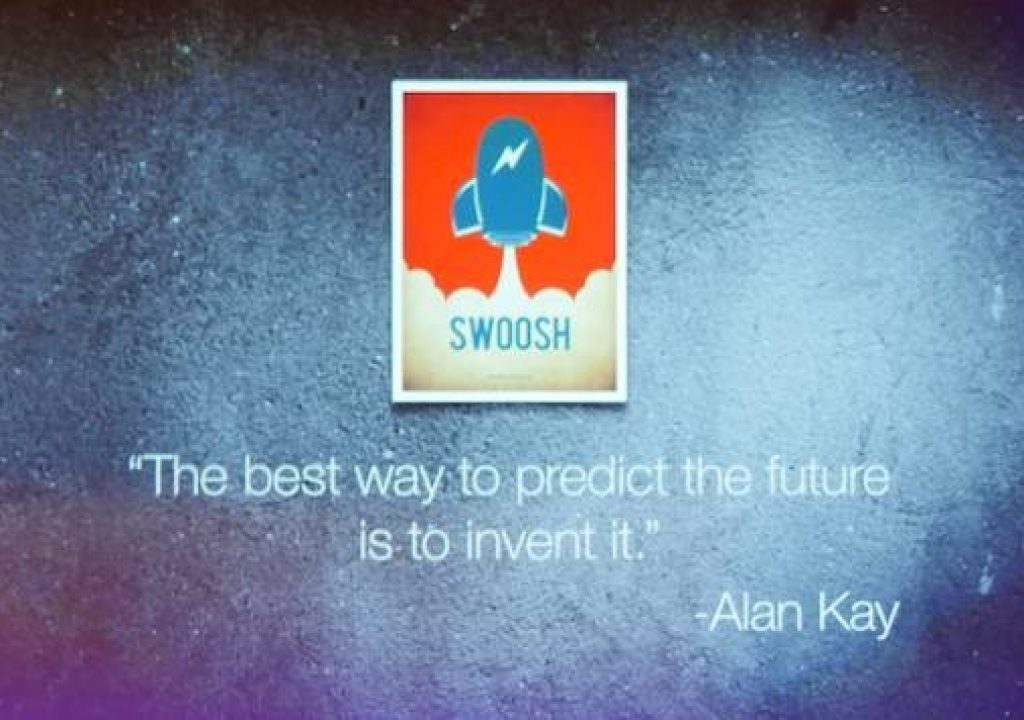Leon Silverman, Michael Cioni, and Mark Schubin start off the discussion of how post is – yet again – evolving.
[Updated 21:25 PST: Some typos fixed (including links to Mark’s video clips). Final, except for various typo fixes and other corrections.]
The HPA Tech Retreat is an annual gathering of some of the sharpest minds in post, production, broadcast, and distribution. It’s an intensive look at the challenges facing the industry today and in the near future, more relentlessly real-world than a SMPTE conference, less commercial than an NAB or an IBC. The participants are people in the trenches: DPs, editors, colorists, studio heads, post-house heads, academics, and engineers. There’s no better place to take the pulse of the industry and get a glimpse of where things are headed; the stuff under discussion here and the tech seen in the demo room tend to surface in the wider world over the course the following year or two, at least if past years are any guide.
I’m here on a press pass, frantically trying to transcribe as much as I can. I’m posting my notes pretty much as-is, with minor editing and probably with horrendous typos; the intent is to give you the essence of the event as it happens. Please excuse the grammatical and spelling infelicities that follow.
(More coverage: Day 2, Day 3, Day 4.)
Jerry Pierce opens. Supersession covers the hot topics that the board sees coming up. If SMPTE is an orchestra, well-defined, HPA is more like jazz. “Shift happens” just as we’re done transitioning to digital, things are shifting yet again. Tech and business models changing. In the demo room, booze will be served: this is the HPA after all!
Leon Silverman, HPA, & Michael Cioni, Light Iron: “Not your Father’s Post”
[Amusing video of Leon Silverman writing to his “wayward son” Michael Cioni, who calls himself a “technologist” and refuses to admit he comes from a post family. Michael replies (via Macbook and iPad) that he’s grateful for the upbringing, but “the kids are alright.” Tries to send email via Siri, but Siri can’t understand him.]
Discussion between Silverman and Cioni. The squeeze: where’s the squeeze coming from? In a discussion, the squeeze is coming from the studios. Look at the market as a business transaction. The content creators have a new boss: alternative distribution methods. Not squeezing just below the line, but above.
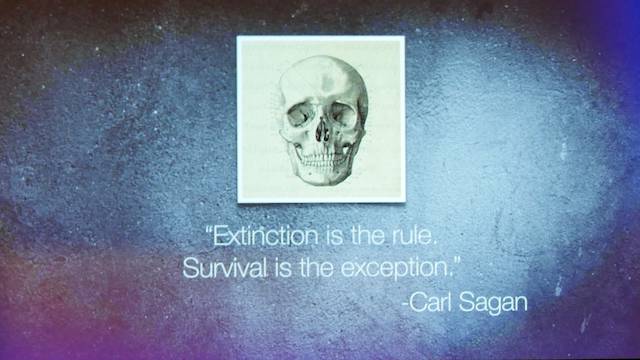
What’s changing is the idea of post. It’s a waterfall, post is going over the edge into the production arena. Services we used to have that we can’t get back; it’s in production and we can’t get it back. “Post” means “behind”, but post needs to be redefined as any manipulation of the image after the camera captures it, even on set, during production. Previz, animation elements, etc. A lot of this previz is discussion-based, while production is mechanical. Transcoding is a pain. In the new Varicam, you can record three formats at the same time, so no transcoding afterwards (complete with LUTs, etc.). This is what all the cameras will do in the future. Also: online, all the time; eliminate online/offline editing distinctions.
So what’s the future of the post house? “Heavy is safe”: Color correction, Atmos, etc. Stuff with high profit margins, widely seen. Top of the pyramid, but there’s not a lot of volume in the top of the pyramid. Automation is key: we at LightIron build dozens and dozens of apps to automate manual processes. That’s where the profit margins are.
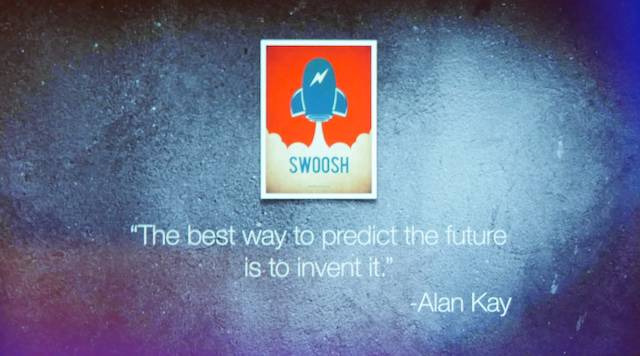
So workflows are becoming more complex? More snowflake workflows? I hope it keeps snowing; a world where we’re still necessary!
But it can’t be chaos everywhere, what are the standards? Standards can be limiting, as in end-to-end color workflow. Mechanical standards, yes; creative standards, no. Distribution standards? Acquisition needs less standards, exhibition needs more. Resolution, contrast, frame rates? The tripod of HDR, resolution, wider gamut. In the ‘70s-‘90s, we got seat belts, airbags, and antilock brakes in our cars; we need them all, and we need all of gamut, HDR, and resolution. Can’t just focus on one of the legs of the tripod if you want to build for the future.
So what is the future: automation, customization. The future of jobs in post? Post is stable, but think of whack-a-mole: the stupid mole doesn’t keep coming out of the same hole. So the jobs are shifting all the time; if you don’t move to a new hole, you’ll be in trouble. Kurzweil’s Singularity: the election of 2042 will be about the droids taking over. The singularity – the fusion of post and production – is happening now. Some elements will remain linear, but vertical integration is increasing.
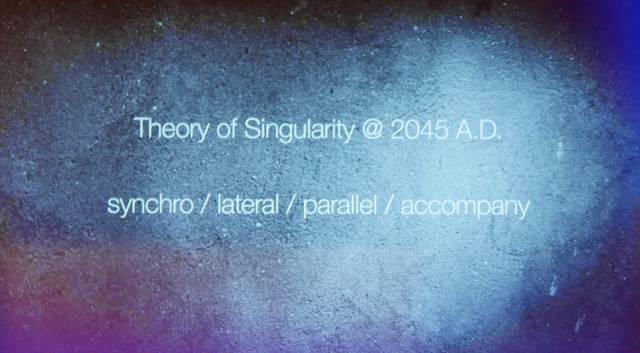
Mark Schubin: “Everything Else”
Not sure if I agree with Michael or not! Everything has post: every movie, drama, commercial, educational video.
Everything else? Live. Non-mass-audience (medical, military, etc.); mass-audience (press conferences, news, sports, events). The press bridge: still awaiting HD!
Two headlines: “Better Call Saul” is huge; Grammy audience is down. But Saul had 7M viewers, Grammys 25M. Event Cinema (live transmissions to cinemas) growing 100% / year. Mark works on Metropolitan Opera HD broadcasts; encores don’t get nearly the same audience as a live show. Super Bowl huge, 165M viewers in the US alone. Consistently the highest audience in TV.
Live has no “do-overs”, no “check the gate”, no confidence playback. Color grading happens live. Live mastering/versioning/editing using different feeds/cuts/mixes for different destinations (US vs Europe). 45 cameras at Super Bowl; long lenses (100:1 zooms) since you can’t reposition the camera for a closeup. Difficult to have those long zooms for 4K and PL-mount LSS cameras.
Can calculate “virtual space” using six cameras to capture the entire field, feed into 3D model, then fly a virtual camera though the resulting space: this can now happen in real time, though high-res is still a bit of an issue. See bit.ly/mark-pf1
Live encoding? Can’t do multi-pass, not in real time. Can’t use high-latency transmission or coding paths, not if you want to mix different elements.
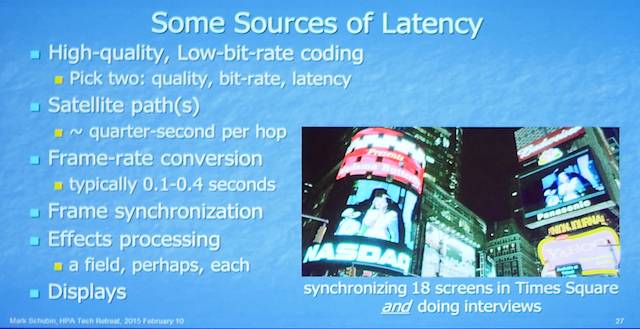
Virtual graphics, like the 1st and 10 overlays on football fields.
“Remoting the remote”: can we have the gear on location (cameras, switchers, etc.) but leave the techs in their home bases (saves $10K/tech in travel costs).
Unintended consequences: digital projectors have a Virtual Print Fee, so often the projectors aren’t used because of the per-showing cost.
Live graphics overlaid on an iPad sports image (augmented reality). See bit.ly/mark-pf2
Live means not being able to say “I’m sorry”!
Is the Met looking at 4K for opera transmissions? No, but taking with NHK about a single 8K camera shooting the entire stage, but Mark feels that it won’t work; not enough res. But HFR, HDR very interesting.
Jeff Joseph, Consumer Electronics Association: “The Revolution May Not Be Televised”
Trends and lessons from CES: TVs are still the dominant consumer tech in households with 97% penetration. 4 acts of DTV: intro, mass-market, replacement cycle, next-gen displays (OLED, 8K, thin/flexible screens, etc.), DTV market peaked 2012, some decline since then, set up for replacement cycle.
Screen sizes increasing: average is now 42”, 60”+ at 15%. 53% people plan to buy new screen in next 3 years. Desired features: picture quality, screen size, display thickness; some increasing awareness of 4K but not yet predominant. But consumers can see the difference between HD and 4K when show both side-by-side; 4K sets are a better value now than a year ago.
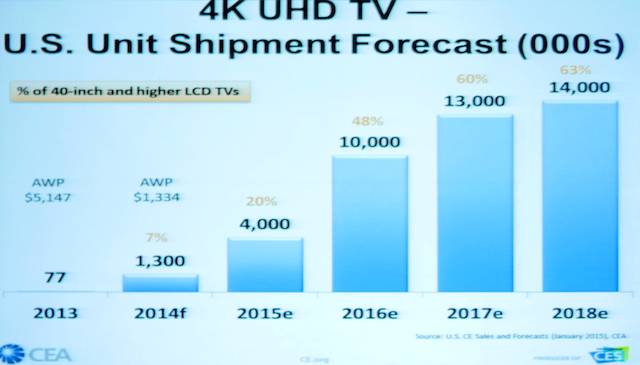
CEA promoting characteristics, logo, nomenclature (4K Ultra HD and 4K Ultra HD Connected), promotions, research.
Next-gen tech seen at CES: HDR, wide gamut, higher bit depth, HFR. OLED, curved TVs expected to uncrease 245% this year.
OTT: this year, internet-only programming will begin to surpass OTA delivery in terms of audience. Streaming has 63% of market, but TV is still the dominant platform even for streaming views. Connected TVs are increasing in sales; the ‘net connection will soon become a standard feature for TVs in general.
TV Summary: smart TVs, 4K, building towards OLED, flat & flexible/curved.
Tablets: new form factors. ASUS PadPhone, Fuhu Nabi touchscreen TV, Lenovo Yoga tablet/laptop/display. Consumer applications, education, vertical markets, retail. The tablet will be a key component on home automation. Prices falling: ASP under $300. Slight decline in volume (market already saturated), slight decline in screen size.
What was cool at CES? The Ring: a wearable device for gestural control. IO Hawk, a sort of hoverboard. Cooki, fully automated cooking device (think of a robot arm with a spatula, and a printer-like device with trays of ingredients). Driverless cars.
Panel: “The Big Screen”
Moderator: Jerry Pierce
John Fithian, National Association of Theater Owners
Todd Hoddick, Barco
David Keighley, IMAX
Curt Behlmer, Dolby Laboratories
[I don’t always keep track of who says what in discussions. Apologies in advance.]
John: 638 operators in NATO, 81 members around the world. We’ve looked at tech issues; there are two aspects to showing films: the movies, and the movie experience. We control the latter. The digital transition was a big deal, but we pulled it off: shared technology standards, very expensive. Stadium seating, better sound systems, more showtimes in multiplexes, etc. Digital transition took 2 billion dollars. Now: immersive audio, HFR, HDR, very exciting, but how can we afford it? Opinions: Despite Peter Jackson and Jim Cameron, HFR isn’ t going anywhere. HDR? Just seeing it, it’s mind-blowing; big future. Lasers are really key for high brightness projection. Hurdles, like legality! Immersive audio works great but is expensive.
Curt: HDR is the most dramatic advance. Immersive audio is great, but HDR is the most noticeable, most impact. Very exciting but very expensive (lasers), high power required. Still challenging, especially in 3D (3D has suffered because people are tired of dim images). 3D not for everyone, but still useful. Theatrical experience is still a social experience, but providing uplift in quality of presentation (seats, food & bev, etc.; image quality) is required to pull people out of their headphones and home screens.
David: Theatrical box office not improving as we’d like. How to get ‘em back in the theaters? Need 14 foot-lamberts, we can exceed that by 50%, but many theaters don’t do that well. Improve social experience if we pay more attention to existing specs. IMAX can do 22 foot-lamberts. But a theater showing 8 ft-L cut to 2 ft-L by 3D glasses, you can’t sell that as “white”. Get the theatrical brightness up where it belongs, we’ll get people back in the seats.
Todd: What we realized was that tech for the sake of tech isn’t interesting; it has to enhance the experience. For shift to happen, need a mental shift. Barco’s guiding principles: enhancing the audience experience, improving the customer’s bottom line. “Even if you’re on the right track, it’s easy to get run over” — Will Rogers. Immersive audio; laser projectors; improving the lobby the way Disneyland uses Main Street to mellow you out and open you to a fantasy experience.
Discussion: should the theater be a leader in tech for image and sound? Yes; but what do we mean? It’s expensive, but the goal is make the best entertainment environment. The immersive experience needs more than just a projector; ambient lighting issues (regulatory requirements). I carry black tape to mask exit signs so they don’t bleed on the screen! Yes, theater has to lead the way, but we don’t have pay to be first. It doesn’t make sense to go to 4K or 8K if the audience can’t tell the difference [applause]. Part of what’s special is the community experience. We go out to see the Met Opera HD ‘casts in Sacramento, my wife likes to get dressed up for the event.
How long until we see HDR in most theaters? This summer (for a commercial implementation). Enough momentum before filmmakers see a market? A couple hundred screens? Maybe not this year, but next. HDR is a huge variable in what it actually means; HDR TV sets vary drastically in performance. How many different deliverables; we already do 400 versions of blockbusters for worldwide release. We have to work with filmmakers on increased gamut as well; how to exploit it.We’re working (at Barco) on museum shows, 40 min, good training ground for gamut and HDR work.
What is HDR: 100 nits, 8000:1? Nobody knows. We have to experiment, show filmmakers, get buy-in, develop the look.
Is that the right question? The promise of laser, and ensuring at least 6 ft-L for 3D movies, might be more impactful than HDR overall.
Will we ever switch from reflected screens to emissive screens? Well, that causes sound problems (speakers behind the screen), but ambient light control is the bigger issue. Remember that most theater lighting systems were designed for unity gain screens; most of our screens today are brighter, but there’s no reason to have an exit sign spilling on the screen.
Is there a correlation between new tech and increased audience satisfaction? We took Chris Nolan, Wally Pfister to see the lasers at Kodak; they loved it. If they liked it, people will come.
I disagree: it’s the audience that counts, we answer to patrons. We collect a lot of data. When we answer to filmmakers, we get confusing information. If we’d put in digital when George Lucas asked us to, we’d have been screwed.
What about more comfortabe seating? What makes the needle move? We can’t predict it. AMC took out old seats in a stadium-type theater, put in recliners, admissions skyrocketed. Exit light masking: need standards, work it into building codes, that’s how you solve it.
Once you have HDR-capable, bright projectors, what about the “bright trailer” problem (like the loud trailer problem)? At Dolby, we remaster everything to limit levels [applause]. An excellent point; we need to consider that.
Ioan Allen, Dolby: Many theaters have refection problems with the walls; as the screen size increases contrast falls. It’s more than just the exit signs! An excellent point: we tell out theater designers you can pick any color as long as it’s black (if you have red seats, they’ll spill on the screen) [but what do you do about those pesky reflective people? -AJW].
We did tests with a big panoramic presentation on The Maze Runner to see if people liked it, so we didn’t just fool ourselves. You have to experiment. Big pushback against immersive audio. It’s all about enabling new paintbrushes, new canvases; not required for every film, but giving the audience choices.
One of the biggest problems is that consumers will be so confused about what HDR should give ‘em. HDR TV display will go all over the place; theaters should strive for a consistent black level and build up from there [applause]. Blacks are hugely important, standards are important, we at NATO agree.
The shaky-seat experience, a.k.a. 4D: motion-actuated seats, where’s that going? We’ll experiment, see where it goes. Has a lot of potential, but is it because it’s only in one theater in LA so far? Gimmickry can’t overwhelm story. Yet another set of formats to implement (“shaky track” in the DCP?). 4D seats can be OK, but it has to be about the story. If the filmmaker is involved in the programming of the seats, it closes the storytelling loop.
Panel: “Shift Happens – Getting [It] There”
Moderator: Seth Hallen, Sony DADC New Media Solutions
Derek Powell, Deloitte Consulting
Chuck Parker, 2nd Screen Society
Kelly Day, AwesomenessTV
Andy Shenkler, Sony DADC New Media Solutions
There’s huge growth in video content consumption across platforms; how do we monetize it?
Derek: Digital Democracy Survey, annual survey of trends. 8th edition, November 2103. How consumers 14 and up interact with media (9th edition to be released in March). Weighted to census numbers.
In 2014: rent vs. buy. In 2015 moving towards OTT on-demand from traditional scheduled programs. Renting preferred to owning by 3:1. Streaming doubled in past year, and expected to keep growing. Millenials at the forefront of this trend. People buy to have physical media and build a personal library. Interest in digital formats outpaces demand for physical media. Movies outpace all other content types, but user generated content (UGC) experienced largest growth. [Many charts, all with type too small to read from farther back than the front row.]
Chuck: changing monetization.
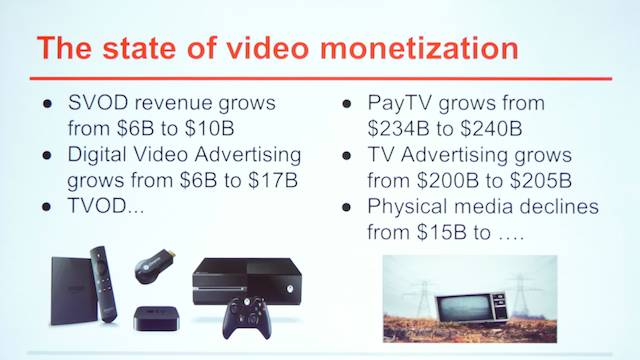
What’s interesting is that none of the top ten networks in terms of viewing are broadcast TV networks.
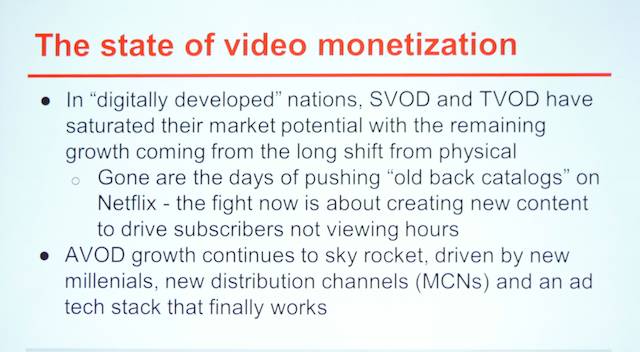
(AVOD is advertising video on demand)
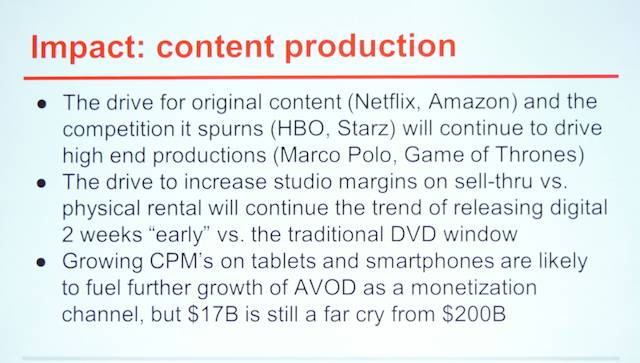
The growth in personalized ad serving and ad-supported video content (not just “on TV” video) complicated delivery chains, requiring more partners and more metadata. UltraHD won’t drive revenue right now; needs too much bandwidth.
Ad tech examples: An ESPN app pushes a touchdown clip to your phone when a college team scores. Now they can put an ad on it, measure impressions, so it’s exploding. Ads tacked onto news clips on all platforms (iOS, Android, Blackberry).
Q: what about Verizon’s abandoning of FIOS? A: It was simply too expensive to provision.
Kelly: AwesomenessTV. MCNs (multi channel networks). What are big companies investing so much in MCNs? AwesomenessTV started as a YouTube channel, now has 1 billion views/month, record label, TV network, acquired by Dreamworks, etc. Also: Maker Studios, 1 billion dollar acquisition, more examples of huge buys. The short answer: reach and relevancy. Viewing habits of millenials, teens, tweens, kids: mostly online, entire generation of social media stars that adults have never heard of. Tapping into talents of these social media stars, distributing through unorthodoix channels to maximize monetization. New ways of thinking about making and showing feature films. “Expelled”, starring Cameron Dallas, released Decenber 2014, no traditional marketing. “Is it a real movie or a YouTube movie?” (Somewhat Ferris Bueller-ish.) Aug 29 2014, greenlit film and started casting. Cameron Dallas part of AwesomenessTV network. Script already in hand. Production started Sep 13, wrapped early October, distributed through Fox Home Entertainment (after 5 weeks of post) the day before Thanksgiving. Premiere Dec 10. Within 12 hours of appearing on iTunes release it displaced Guardians of the Galaxy. Now on Netflix.
How did we do that? Starts with casting:
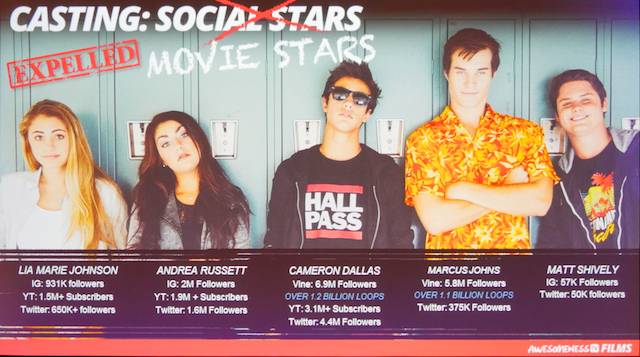
Massive social media stars: Cameron Dallas has multiple millions of followers on Twitter/Vine/Instagram etc.; the others are close behind. Combined reach exceeds 10M teenagers in US alone. Audience will follow ‘em anywhere and will happily spend $10 to see them in a movie. #1 on iTunes on 1st day, 8,000 reviews. 3.88 million social mentions from October to year end. The fans feel like they’ve created these social-media stars.
We’ll release at least 3 more feature films this year, one with the Smosh guys, if you know them. MCNs have a lot of freedom to experiment and take risks, could change the face of how TVs and movies are made and distributed.
Andy: What we’ve been working on: Ven•ue. White-label platform, end-to-end solution so content owners can run an extensive OTT and e-commerce environment to distribute and monetize content. Content prep & delivery, commerce, security, authentication, supply chain service, multi-screen authoring, rights management & avails, online video player, consumer engagement. “Netflix in a box.” The player looks like Netflix or Amazon TV.
Everyone’s focused on ad insertion, but we shouldn’t clutter up the screen or prevent the user from doing what he wants. So while we jog/shuttle, we insert sponsorships (logos) during the few frames of delay before the video loads. Can target it to the device (sell Pepsi on Xbox, sell Coke on Android). Also traditional ads: “at 15 minutes, schedule a discount or a download or other reward (after an ad break)”
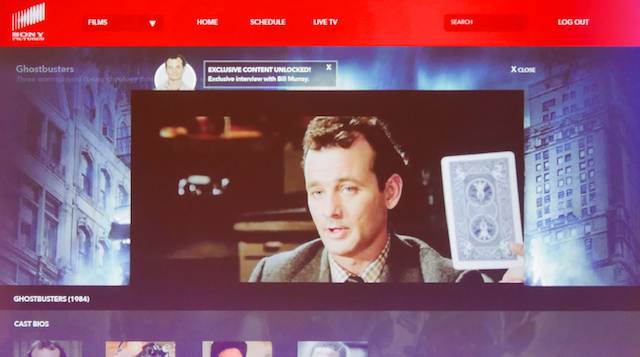
So if you experience an ad, you’ll also get rewarded: but not every ad, and we disable it if people scrub the program looking for rewards so they can’t game the system.
Never a dull moment: instead of static art, use video backgrounds instead; always have something happening so you don’t see “Loading…” Lots of work to present a consistent view across devices, without making it look like a web view ported to each device, and still paying attention to the differences between platforms.
Binge-watching is expensive for the service provider. If you have Game of Thrones, Dr Who, someone can curate excerpts and clips so that a fan needn’t watch everything to catch up.
Always a bug onscreen for current and upcoming purchase opportunities; it’s not just a streaming platform, it’s an e-commerce platform. Always make sure the purchases can happen without interrupting playback. Has been hugely profitable in tests so far. Completely socially integrated.
Easy authoring tools for adding these popups and bugs and opportunities onto a stream.
Panel: “Cyber and Content Security: Time for a Strategy Change”
Moderator: Kari Grubin – NSS Labs
Vikram Phatak – NSS Labs
Frank Artes, NSS Labs
Theresa Miller, Lionsgate
Bryan Ellenburg – CDSA – Content Delivery & Security Association
Ted Harrington, Independent Security Evaluators
Who are the perps? How easy can they gain access? How do we understand the risks? How do we set standards?
Ted: Who are the adversaries? Activists, foreign governments, hackers. Motives may not overlap.
Attack types and examples. The first iPhone hack in 2007; many parallels to today. Innovative new tech, new risks. exploitingiphone.com Buffer overflow in mobile Safari: attacker-controlled website could get full administrative access and control. Snapchat, the ephemeral-messaging app; hacked a year ago. You allow Snapchat to access your contacts, Snapchat says which ones also use Snapchat. But Snapchat forgot to use rate-limiting on password attempts, so hackers brute-forced Snapchat logins and got (a) valid phone #s, (b) who uses Snapchat, (c) username/password pairs, etc.
Think of security as an ongoing process. Feature-creep adds attack surface in a continuous basis, but security audits happen infrequently, so unexamined attack surface is minimized. Costly? Not really; less expensive (after the first audit) to re-examine security in fine increments.
Heartbleed; an OpenSSL vulnerability. The heartbeat signal requests a response of a specified size; the attack requests more characters than were sent, so you’ll get whatever was in memory at that time: passwords, encryption keys, etc.
The thought is that open source has more eyeballs on it, so it better… but that didn’t work for Heartbleed because not many people actually looked at it.
Make sure you audit; make sure your audits match your goals. Automated scanning is a first step, but only a first step.
Frank: How aware are you? What you don’t know that you don’t know… If I could only get everyone to stop using their mobile devices…
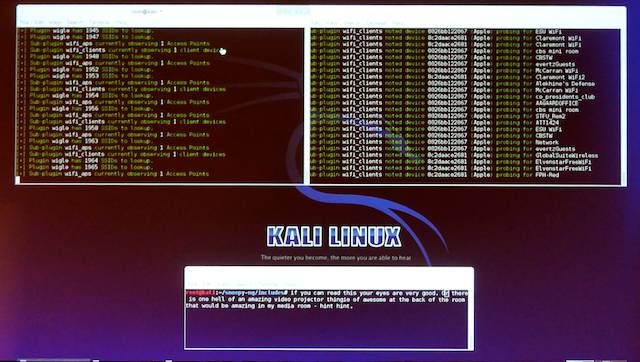
This is a real hacker interface, running now, showing all your mobile devices on WiFi here! Passwords, various SSIDs the devices were looking for, MAC addresses…
[shows Google Maps displaying street views of some of the SSIDs he collected.]
Three rules: Rule 1, your technology will betray you.
Harvest this stuff, cross-correlate… I’ve seen lots of USC and studios here. I can see from the SSID queries who works together, what sorts of places you go.
Rule 2: Your blind faith in security products will not end well.
Average IT headcount security headcount will grow from 22 in 2013 to 29 in 2014. New tech to improve your life is often brought to market without security reviews (got a BMW? I can open the doors, start the motor for you!).
More research: one hack to get 10s of millions of account data, then did it again, to see how people changed passwords, so they can build a predictive model of how people change passwords!
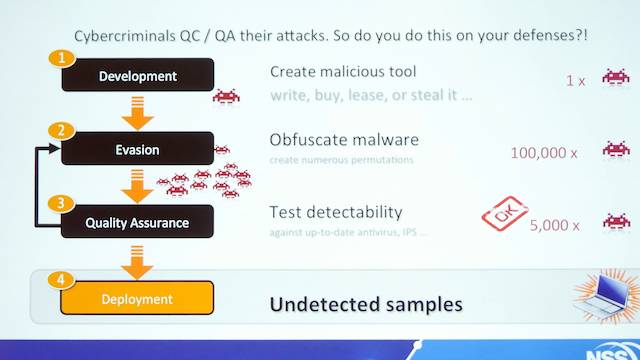
After they test and QC this, they only deploy the code that evades detection!
Threats: It’s not the 98% you catch that matters, it’s the 2% you don’t catch! Risks change depending in attack surface, threats, etc. What do cybercrims do:
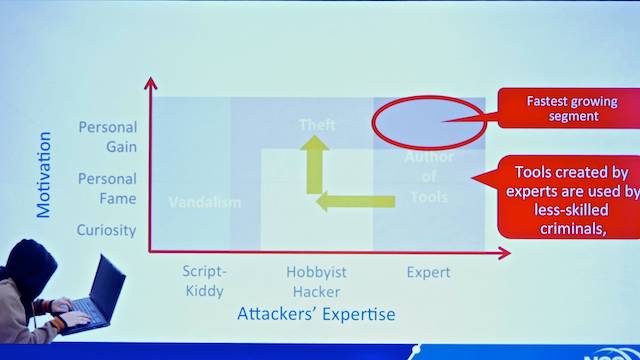
Average 153 days to patch a vulnerability. Average 312 days before they’re even detected. Overall more than 465 days of potential exposure.
A year’s worth of data: exploits that get past security products:
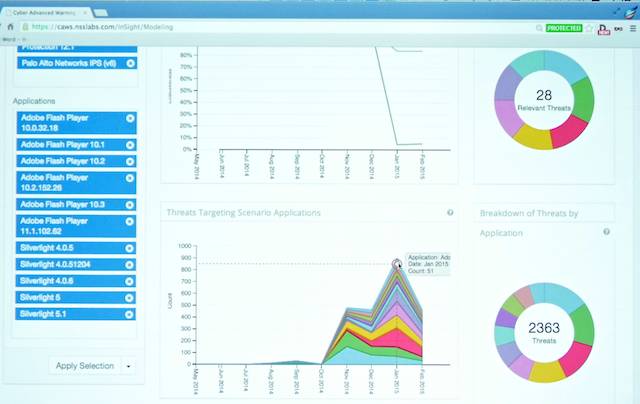
Theresa: The Sony hack was huge for our industry. So we look at how much data we keep, what our disaster recovery looks like (was focused on earthquakes, now as much on hacking). A lot of attention in insider threats as well. Q: Was there a way to prevent it? Not really; our execs realize it’s almost impossible to prevent it. We try to make it as difficult as possible, but we’re also focusing more on resiliency as well as on prevention. Q: What about working with outside vendors, open systems? It’s a huge opportunity to get together to work on certifying technologies and finding ways to secure things. The studio is evolving in how much it spends in security as well as doing things like security reviews.
Q: New standards and practices? [Not sure who’s talking. -AJW] Pulling together multiple vendors on a production exposes more vulnerabilities compared to a standardized in-house process. There’s a lot of training and education needed in the industry to plug the leaks: access control systems, forensic watermarking, better processes. The thought had been that security is disruptive and adds cost, but products exist that streamline things like content transcoding and transport while increasing security compared to ad-hoc manual processes.
Questions from the audience: How do I close some of these holes? A: Turn off WiFi and bluetooth radios when you aren’t using ‘em. Your WiFi device asking, “hey, home network, are you there? Hey Starbucks, are you there?” I could spoof one of those access points… Q: should we “forget networks” when we’re done with ‘em? A: Yes. Q: Is mobile data safer than WiFi? A: Yes, a bit. Q: Training for human factors in security? A: Yes: think “social engineering”. We look at management: are they serious about security? Annual training we don’t see so much, but the threats are always evolving. I expect we’ll see less open access to content, anywhere and everywhere. It’s inaccurate to say there are only X people working in security; we’re all working in security. The IT people should be playing at being bad guys, and trying to social-engineer their way into their own ‘nets. Theresa: at Sony we’ve already seen people segregate their personal emails from company emails. Q: How should we secure our home WiFi networks? A: It’s impossible to find a secure home router at Best Buy! Simple stuff helps, like changing default router passwords, but it’s not perfect. Q: How well do corporate VPNs help in a room like this? A: Depends on the VPN. It comes down to the level and durability of the cryptography used. IPSec is good, can’t do a simple MITM attack because the IPSec tunnel will collapse. Q: Cloud security for things like AWS? It’s gotta be better than homegrown corporate stuff, right? A: Cloud used properly is more secure than sneakernet, as long as you have routine penetration tests, protect passwords, etc.; systems are only as secure as the people using them. Three kinds of people with regard to cloud: irrationally afraid of it, irrationally confident of it, and everyone in between. We try to push people into the middle group. Q: Is SSL not secure? A: No, it’s OK, just be careful of how you’re implementing it. Q: How secure are ISPs? I have Time Warner, the tech said, “oh, try logging in as ‘technician’ with the password ‘timewarner’”. A: They all have backdoors for central control. If you let someone else have control, they have control. Try replacing the word “cloud” with “someone else’s computer” as in, are you happy putting pre-release programs on “someone else’s computer”? If not, put “cloud” back in and you might feel a bit better…
Panel: “The Creative Panel”
Moderator: Carolyn Giardina, The Hollywood Reporter
Howard Lukk, Pannon Entertainment
Stephen Poster, ASC, International Cinematographers Guild
David, whose last name I don’t have – color grader, worked on “Life of Pi”
Carolyn: What tech is most exciting for you?
Howard: HDR
Daryn: HDR for theatrical to enhance the experience, and immersive sound
Stephen: ACES. I’ve been taking about end-to-end color management for over 20 years, and ACES is the most exciting thing.
David: HDR.
Carolyn: Dead on arrival? Least excited about?
Howard: High frame rate (HFR).
Daryn: HFR. A novelty, but it pulls me out of the movie.
Stephen: Motion interpolation on consumer sets.
David: I agree with Stephen. If we wanted that, we’d shoot HFR, but I don’t like HFR.
Carolyn: Creative intent? What’s working?
Stephen: The most important thing we’ve recently got is the ability for the DP to grade on the set. The idea that we can grade on-set and the grade follows the image through to post is very exciting. If you’re working on a calibrated system, the edit suite will understand what it is you’re doing, the producers can understand what the final product should be.
Howard: I think that on-set grading is distressing: there are so many things happening during production you don’t want to get distracted by grading. Point your light meter, set the camera, shoot it, you’re done.
Stephen: We can still shoot fast but capture creative intent. I did the rough grade in video village, and the intent was preserved.
Howard: As a filmmaker, do we grade for each different HDR display? Versioning is a huge issue.
David: HDR is interesting; 4K doesn’t make the same difference. We don’t want the bulk of the image to be high-contrast, but when you get a glint or the sun or an explosion, you can have that – and you can keep blue skies blue in the process. Use it in moderation: full HDR for 2.5 hours is like having someone scream at you for 2.5 hours.
Carolyn: Standards?
David: Right now everyone is tring to create new HDR standards, everyone wants their own to be the standard, but there’s no agreement. So when I grade an HDR show today, I’m grading for a particular technology.
Howard: worked on “Emma” HDR short with Daryn Okada, and we were a bit too soon. Wonderful experience. It’s a dark thriller, and pulling everything out of the blacks begged for an HDR finish… but at the end of the day it’s the story that counts.
David; You hear “HDR” and you think of bright stuff, but it’s in the blacks that things are exciting.
It’s not how many nits, it’s how much contrast we have.
Stephen: It’s a choice, we can capture it and then throw it away if we want to. It’s not the ability to see everything in the grayscale, it’s the ability to choose and use those values as the artist sees fit.
Carolyn: HFR? Is there a place for it?
Daryn: Not in my life!
Howard: If you want closer to reality, HFR works. If you could do variable frame rates in a show, that would be interesting. [think “Brainstorm” in its original Showscan version. -AJW]
Stephen: HFR destroys suspension of disbelief. Can you re-interpolate 120fps material into something that allows suspension of disbelief? Look, we saw contact lenses in “The Hobbit”, and bad-looking sets. 24fps is the best possible way of suspending disbelief. Even 30fps, which we used on some commercials, didn’t feel right. It’s be great if we could do brain-scan tests to see how we’re affecting the audience.
Daryn: The only time to use HFR is if it’s scriptable, so you can call it in where you need it (to eliminate strobing, for example, more visible in HDR material). That might be exciting. But it’ll keep the experience comfortable for the audience.
Carolyn: 4K?
David: 4K and UltraHD, for the home, at a certain distance you don’t see it, but the clarity of the dot pitch is great. For acquisition, the way to boost resolution, it’s still not true resolution due to Bayer patterns, etc., so it’s just numbers, and it might have other adverse effects. So ask: why are we doing it?
Stephen: On last show I had the choice to go 4K on the C500. I went 2K 12-bit instead for more color depth. What I’m excited about is the quality of the sensors; it started with Alexa and the Canons, and we’re seeing more photographic quality. I shot my low-light stuff at 3200 ISO, with low noise, more like film grain; felt more like film. Higher quality better than 4K or HFR.
Daryn: I’ve shot 4K for 2K release, for oversampling. But I’ll always trade resolution for bit depth. That’s the magic: bit depth, HDR, the ability to render textures.
Howard: contrast and resolution are married, you can’t separate ‘em.
Stephen: I’m excited by seeing more use of glass diffusion than I have in a decade. What actor wants to see every pore?
Daryn: When you move from a wide shot to a closeup, diffuse; relight. What the resolution gives you even when you soften the image is that natural tonality; it’s not a waste of resolution, it’s orchestrating it.
Stephen: Filters don’t degrade the image, they enhance the image. The idea of 4K because editors can push in for a closeup? It’s the wrong way. It’s a completely different emotional feeling.
Daryn: When people tell me this I explain how al the VFX have to be captured at 4K and then downrezzed, and all of a sudden I’m getting a call from post.
Carolyn: What do manufacturers need to build?
Howard: True HDR displays.
Daryn: One theatrical standard for HDR. We can’t grade for al the different sets; we need a way for grading that doesn’t throw stuff away, like OpenEXR and ACES; not what they were designed for perhaps but they have the headroom to keep all the information. Doesn’t all have to be 4K ACES, can be 2K or HD ACES.
Howard: that was the beauty when we did “Emma”, we have all the data in the can. Maybe we can’t make the perfect HDR version today, but we can later. ACES worked great for this film. It’s still way too early in HDR to say what we need; we don’t know what we don’t know.
Daryn: That’s why I’m excited by ACES; at least we can master to a standard today, and remaster later because we haven’t thrown anything away.
David: When doing “Book of Life”, given to us in OpenEXR as if acquired in HDR, it gave me a lot of information to control the soft falloff of clips. Because it was OpenEXR, with HDR coming out, I can revisit it; I have the neg, I’m not trying to work from a print. We remastered The Black Stallion from original neg and the dynamic range on that neg was breathtaking.
Carolyn: Wish list?
Stephen: Can’t there be some form of header/descriptor on every bit of media to tell the display how to display it? Montion-interpolated for sports, perhaps, cinema mode for films, etc. If not that, one button on the TV set.
Howard: Make the little cameras on the TVs stop spying on us and just monitor ambient light!
Q: HDR is like sound: when we had only 40dB to work with, OK, but with 90dB, where you put dialog? Will HDR be the same? Daryn: We know where the black point wants to be. How do we use that minimum amount of DR to affect the audience is something we’ll learn. The easy selling point is bright-bright-bright! But that’s not want we want to do.
Q: Is -18dB the equivalent of midgray? David: perception of contrast is very different in HDR without ambient light, as we have during normal DR material. A standardized curve will make a difference; are skintones at 30%, perhaps. It’s all about perception; difference like between grading TV shows and DIs.
Panel: “Post in the Era of Over the Top”
Moderator: Loren Nielsen, Entertainment Technology Consultants
Stephen Beres, HBO, tech operations
Sara Duran-Singer, Head of Post for Netflix Originals
Loren: The new world of over the top (OTT). They’re now content creators. HBO famous for quality programming; HBO Go for other platforms. HBO and Netflix both leaders, now both embarking on event programming. Steve, what’s happening at HBO?
Steve: We started original programming decades ago; moved into nonlinear content (mobile devices, Xbox, etc.). More of a platform than we ever had in the past, not just on cable any more (140M viewers worldwide). We now find ourselves in the event market (Game of Thrones IMAX Experience); it’s not TV, it’s HBO. More forms of consumption than ever before.
Sarah: Last year we launched 28 shows, this year 70, next year and afterwards, 20 more each year, across episodics, docs, features, comedy, etc. The vision is a global entertainment streaming company. Around 56-58M subscribers. Currently in Cuba, launching in Australia and Japan. Season 3 of House of Cards starts 27 Feb!
Loren: Netflix developed the idea of binge viewing
Sarah: We tried to find an alternative term, but finally gave up!
Loren: To enable that, you need 13 episodes ready at once. How do you handle that?
Sarah: They aren’t all episodics, fortunately. But we’’re working with partners and hiring more people. We work with smart people and we trust them. You don’t necessarily start with the streaming deal, you work with the best talent. With House of Cards, MRC understands our process, and it’s the 3rd time through.
Loren: Stephen, has HPO considered delivering more than one episode at a time?
Stephen: Yes, we all consider it. Netflix has made everyone question whether our (original) approach is still relevant. Linear TV was the model: we build excitement between episodes, we cause our viewers to have an opportunity to share what they’ve seen. We find we build a sense of community around a show like Game of Thrones regardless of how it’s shown. We find that you show a few episodes, viewers spread the word, and audience grows. Binge viewing? We’re like goldfish: we’ll eat until we explode! Having time between episodes allows you to build a world around the show, think about stuff not shown… there’s a cost to binge viewing as well as benefits. But Netflix has changed the game.
Loren: Talk about cinematic quality…
Stephen: HBO has an accepted hallmark of quality. Cinema on television was our mandate, and we’ve kept that as part of our visual DNA. I think we thought that was attributable to shooting 35mm film. We still love it; we’re the last bastion of it, we’ll do it until we can’t any more. The HBO look is informed by that. As we look at camera systems, we pay less attention to numbers, more to how it looks: “could that be on HBO?” First nine Alexas on Game of Thrones; first network show to add synthetic film grain to a show… do what we need to maintain that cinematic aesthetic.
Loren: Both companies are international. Distributing titles in all territories; how many versions for same-day release?
Sarah: We localize: subtitles, etc. Built into workflow. Was mostly done by partners, we’re bringing it in-house. Looking for the best talent to do translations, to capture the idioms of the character and the show. Localizations and secondary assets are extremely important. That being said, we don’t edit for content, we don’t do country-specific edits. The viewing audience loves Hollywood content; the production values are so great, and the recognizable actors. It’s not just US content, it’s worldwide content. One video stream, with multiple subs and dubs.
Loren: New tech at HBO?
Stephen: As Michael Cioni said, the triad of resolution/color/contrast is critical. In a few years, you won’t be able to buy a camera that won’t shoot 4K. Value for dollar comes more with color and contrast than resolution, especially on the small screen, but it scales up, too. Humans care more about color and contrast than resolution. Using that tech to empower creativity is key. Viewers are more savvy; distributors are starting to become more discerning: we don’t necessarily care how it was captured. What Stephen Poster said about 2K 12-bit instead of 4K is very intelligent. We’re working with companies like Technicolor and Dolby to develop these sorts of things. And it has to work on plain old cable, too!
What Just Happened? A review of the day by Jerry Pierce and Leon Silverman
Seat belts, airbags, and brakes relate to resolution, contrast, and color. What else did we learn?
The CEA expects HDR in a couple of generations while theatrical wants it now?
Not many people have 4K sets or expect to buy them (by show of hands). One person in the audience has a curved TV. Most have 5.1 audio in their house. Only one person wants a robot to stir his dinner.
How about that production timeline for “Expelled”?
“With great contrast comes great responsibility.”
“Scared shiftless; I’m going back to snail mail.” Several people have cleared their WiFi access lists since the security session.
We have heard yet again that frame rate is a preference, not a parameter.
AI is what you call software when you don’t know what it does; HDR is what you call a better picture when you don’t know what it is.
We talk about delivering the best quality we can, yet a lot of consumption is on crappy displays. Is there a minimal acceptable quality?
No comments this year about Ultraviolet. [That was a comment, not an editorial insertion on my part. -AJW]
Disclosure: I’m attending the Tech Retreat on a press pass, which gets me free entrance into the event. I’m paying for my own travel (car), local transport (bike), hotel (Best Western, about two miles away), and meals (Native Foods Monday night; probably Del Taco tonight). There is no material relationship between me and the Hollywood Post Alliance or any of the companies mentioned, and no one has provided me with payments, bribes, blandishments, or other considerations for a favorable mention… aside from the press pass, that is.

Filmtools
Filmmakers go-to destination for pre-production, production & post production equipment!
Shop Now